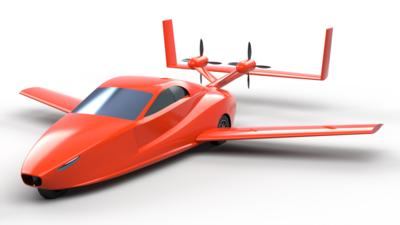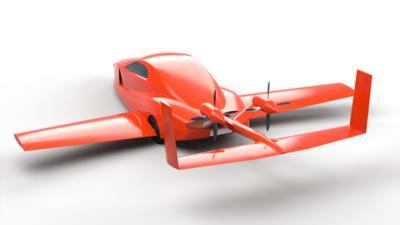Refreshed Design is Sleeker, Quicker, and Better All Around
Samson Sky had mentioned that its flying car, the Switchblade, would be getting a few aerodynamic and production tweaks as they move towards production, but their newest announcement surprised AirVenture attendees with a fully revamped fuselage design.

The Switchblade's original form was more rounded and complex in comparison, with the new iteration sporting a more unified, muscular, creased design. It's a good look, and it's apparent from the get-go that Samson put a lot of work into making something aerodynamic while being simple enough to produce in quantity. Most noticeable is the Switchblade's missing ducted fan behind the passenger compartment, which dominated styling by letting a whole lot of daylight through the design when seen from the sides. The long side strake that fed air into the pusher prop was one of Samson's biggest points of interest when going on its campaign of aero improvement, and its disappearance in the production aircraft goes to show that the ducting didn't add enough performance to make the added drag worthwhile.
Samson Sky Founder Sam Bousfield said they'd taken a wholistic approach to the aerodynamic redesign, looking to improve nearly every aspect of the Switchblade. The end result? A much sleeker, less visually 'busy' design. “When all configurations were reviewed," he said, "there was no question that we should embrace a more streamlined body design with thrusters,” said Bousfield. “It allowed us to keep what worked well during flight testing, plus more fully protect the flying surfaces in ground mode.”
So what else changed? A whole lot. The basic underpinnings of the Switchblade remain, like their wing deployment and overall layout, but performance is improved just about everywhere else. The wings have gained some extra square footage, up to 99 sq. ft from 667 sq ft on the last model. Max gross takeoff weight is up to 2,600 pounds, with a lower takeoff and landing speed to boot. The little slots and vents of the original Switchblade are gone too, with thrusters placed in clean air to improve propeller efficiency in flight.

The streamlining also made the Switchblade more 'carlike' in driving mode, tucking everything into a chassis that looks like it belongs on the road, no baubles, winglets, or aero aids sticking out. The new tail design folds into the body, so that the assembly is better protected while driving around in everyday traffic. In ground testing, the little trike is able to pull off 125 miles an hour - and Samson Sky says that it beats "everything in its wheelbase class in the Road & Track slalom course. Add in a projected 0-60 mph time of 5.6 seconds and it makes for a fun little thing on the road, even if it can't quite top the leaderboard in the quarter mile. (It's an aircraft, after all. Until there are Hellcats with ailerons and an empennage, the Switchblade is alone in the strip.)
To drive the new performance goals, Samson Sky had to go back to the drawing board to give it a full hybrid electric drivetrain, giving it the best of both worlds. Electric power is great for torque and a good way to establish a baseline of roadgoing performance from a dig, but slowly recharging the batteries would really put a drag on cross-country flight plans. So, Samson Sky put in a 40-gallon tank, allowing pilots to quickly refill and be back on the road... or sky. That drive train is a sticking point for some, though, but new and unproven power systems often take some time on the market to build trust. Only time will bear out whether the revised hybrid drivetrain is up to the task of reliable, consistent power output throughout the life of the aircraft.
The Switchblade's new form will be entering the production phase soon. Samson has 3 prototypes slated for production over the coming year and a half, which will validate the assembly process. Once they get the go-ahead, serial production can kick off to start filling the reservation list of 2,600 would-be Switchblade pilots. First up, however, will be delivery for the 530 buyers with a deposit on hand.
 NTSB Final Report: Rutan Long-EZ
NTSB Final Report: Rutan Long-EZ ANN FAQ: Turn On Post Notifications
ANN FAQ: Turn On Post Notifications Classic Aero-TV: ICAS Perspectives - Advice for New Air Show Performers
Classic Aero-TV: ICAS Perspectives - Advice for New Air Show Performers ANN's Daily Aero-Linx (06.28.25)
ANN's Daily Aero-Linx (06.28.25) Aero-News: Quote of the Day (06.28.25)
Aero-News: Quote of the Day (06.28.25)




